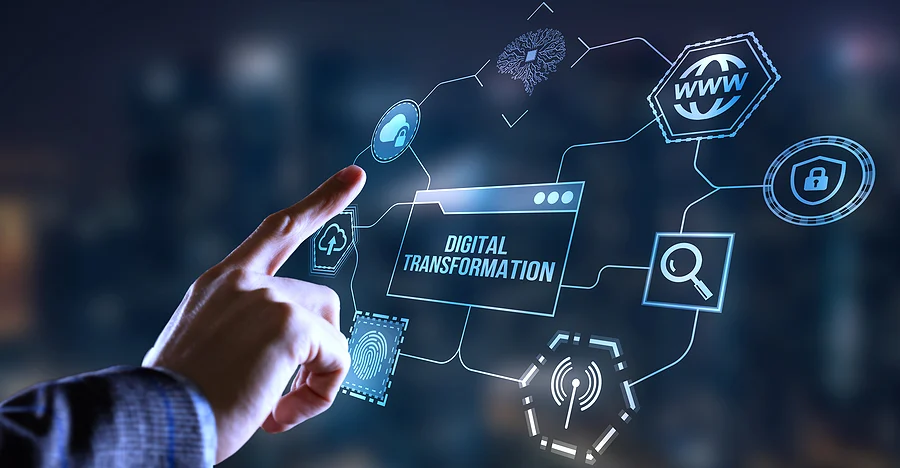Top 7 Business Digital Transformation 2025

Top 7 Business Digital Transformation Trends That are Must Embrace in 2025
By Muhammed Riyaz, Head of Digital Strategy | Zylox Infotech |
Let’s face it – keeping up with business digital transformation can feel like running on a treadmill that keeps getting faster. Trust me, I’ve been there. After helping dozens of businesses reinvent themselves through technology, I’ve seen firsthand what works and what falls flat.
In this constantly evolving landscape, some trends are just too significant to ignore. Here’s my take on the seven digital transformation trends your business absolutely needs to embrace in 2025 – based on real results, not just hype.
1. Hyper-Automation: Working Smarter, Not Harder
Remember when we thought basic automation was revolutionary? Those days are long gone. Today’s hyper-automation combines AI, machine learning, and robotic process automation to transform entire business processes.
I recently worked with a manufacturing client who was skeptical about implementing an AI-driven automation system. “We’ve been doing things this way for 20 years,” they told me. Six months after implementation, they saw a 32% reduction in operational costs and practically eliminated unplanned downtime. Business digital transformation The numbers speak for themselves – Gartner’s research confirms this isn’t an isolated case, with most organizations lowering operational costs by about 30% through similar approaches.
What you should do:
- Start small – identify one repetitive process that eats up your team’s time
- Look for AI tools that learn from your data rather than requiring constant programming
- Connect your automated processes so they talk to each other
- Measure the time and money saved to build momentum for bigger projects
2. Edge Computing: Because Sometimes Milliseconds Matter
If you’ve been putting all your data in the cloud, it’s time to rethink that strategy. While the cloud isn’t going anywhere, edge computing is changing the game for applications where speed really matters.
I still remember a healthcare provider client who was frustrated with their patient monitoring systems. “By the time the alert comes through, it’s already too late,” their CTO told me. After implementing edge computing, their response times dropped from over a second to under 50 milliseconds. In healthcare, that’s not just an improvement – it’s potentially life-saving.
According to IDC, we’re approaching a tipping point where 75% of enterprise data will be processed outside traditional data centers. This isn’t some far-off future – it’s happening now.
What you should do:
- Identify processes where real-time response is critical to your business
- Consider hybrid approaches rather than an all-or-nothing strategy
- Don’t forget about security – distributed systems need distributed protection
- Start planning for 5G integration to maximize edge capabilities
3. Composable Business: Building Your LEGO® Organization
I love using the LEGO analogy with my clients. Traditional businesses are like models glued together – when something needs to change, you often have to break things. Composable businesses are like LEGO creations – you can reconfigure pieces without starting over.
A retail client of mine used to take 6-8 months to launch new digital experiences. After shifting to a composable approach with API-first development and microservices, they can now roll out changes in weeks. When the holiday shopping season threw them a curveball last year, they actually adapted faster than their competitors.
Gartner’s research backs this up – companies taking this approach are implementing new features 80% faster than those stuck in monolithic systems.
What you should do:
- Embrace APIs as products, not just technical necessities
- Break down monolithic applications into microservices when upgrading
- Create a catalog of your business capabilities so you know what “blocks” you have
- Focus on interoperability in every technology decision
4. AR/VR That Actually Makes Money
Let’s be honest – a few years ago, AR/VR was mostly gimmicky marketing. Not anymore. These technologies have matured into serious business tools that drive real results.
I was initially skeptical when a furniture retailer wanted to invest heavily in AR. But their app, which lets customers see exactly how products would look in their homes, boosted conversions by 40% and cut returns by nearly a third. The technology finally caught up with the promise.
With the AR/VR market projected to hit $72.8 billion by 2026, this isn’t just experimental tech anymore – it’s becoming essential for certain industries.
What you should do:
- Look for practical problems these technologies could solve (visualization, training, support)
- Start with mobile AR if you’re new to this space – the barrier to entry is much lower
- Focus on the customer problem, not the coolness factor
- Measure concrete outcomes like conversion rates, not just engagement
5. Total Experience: Breaking Down the Experience Silos
Here’s something I’ve noticed working with dozens of companies: they often have separate teams for customer experience, employee experience, and user experience – and none of them talk to each other! Total Experience (TX) changes that by recognizing these are all connected.
When Bank of America implemented a unified TX strategy, they didn’t just see a 27% jump in customer satisfaction – they also got a 22% boost in employee engagement. Why? Because happy employees create happy customers, and intuitive systems make everyone’s lives easier.
What you should do:
- Map the journeys of both customers and employees to find connection points
- Create cross-functional teams that break down experience silos
- Implement consistent design systems across all your digital properties
- Use shared metrics that matter to both customers and employees
6. Zero-Trust Security: Because “Trust But Verify” Doesn’t Cut It Anymore
If 2024 taught us anything, it’s that cybersecurity threats are getting scarily sophisticated. The old castle-and-moat approach to security (strong perimeter, trusted internal network) simply doesn’t work in today’s world of remote work and cloud services.
I still wince thinking about a client who suffered a major breach despite having “strong security.” Their mistake? Once attackers got past the firewall, they had too much freedom to move laterally. Zero-trust would have stopped them cold.
IBM’s research shows organizations with zero-trust implementations save an average of $1.76 million per breach incident. But the real value is in the breaches that never happen.
What you should do:
- Implement strong identity verification for everyone – no exceptions
- Give access to specific resources, not entire networks
- Continuously verify connections, not just at login
- Segment your network to contain potential breaches
7. Sustainable Technology: Good for the Planet, Good for Business
Sustainable technology isn’t just about feeling good – it’s about smart business. Energy-efficient systems cost less to run. Optimized software needs less computing power. Circular economy principles reduce waste and hardware costs.
One of my favorite success stories is how Google used AI to optimize cooling in their data centers, cutting energy use by 40%. This wasn’t just an environmental win – it translated directly to their bottom line.
Accenture’s research suggests sustainable technology could help reduce global carbon emissions by 20% by 2030. But you don’t have to wait until 2030 to see the benefits.
What you should do:
- Audit your current technology stack for energy efficiency
- Consider environmental impact in your procurement decisions
- Optimize your software – bloated code uses more energy
- Use IoT and smart systems to reduce resource consumption
Let’s Get Real About Business Digital Transformation
Here’s my honest take after years in this field: digital transformation isn’t about technology. It’s about rethinking how your business creates and delivers value. The technologies I’ve outlined aren’t silver bullets – they’re tools that enable new possibilities.
The organizations that succeed don’t just adopt these trends – they adapt them to their specific challenges and opportunities. They start with the problem, not the technology. And they recognize that digital transformation is a journey, not a destination.
At Zylox Infotech, we’re passionate about helping businesses navigate this journey with practical, results-driven approaches. We’ve seen these trends drive real results across industries, and we’d love to help you do the same.
Ready to take the next step? Let’s talk about which of these trends could have the biggest impact on your business. Drop us a line – no sales pitch, just straight talk about your digital transformation challenges.
Sources: This article draws on research from Gartner, McKinsey and our own implementation experience with clients across industries. While we’ve cited specific statistics, remember that your results may vary based on your specific implementation and industry context.




